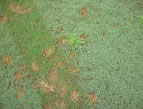New herbicide resistance tool

An annual bluegrass plant survives while surrounding annual bluegrass plants were controlled by a herbicide application. Photo: Weed Science Society of America
The Herbicide Resistance Education Committee of the Weed Science Society of America has released a new series of training modules on herbicide resistance management developed specifically for turf.
Each training module is brief, well-illustrated and easy to understand. The specific modules are:
◾ Lesson 1:
Current Status of Herbicide Resistance in Weeds
◾ Lesson 2:
How Herbicides Work
◾ Lesson 3:
What is Herbicide Resistance?
◾ Lesson 4:
Scouting After a Herbicide Application and Confirming Herbicide Resistance
◾ Lesson 5:
Principles of Managing Herbicide Resistance
Cases of herbicide-resistant weeds worldwide are becoming increasingly common since the first reports of their occurrence in the 1950s. These biotypes survive herbicide application at doses that usually give effective control of the species. Resistant weed biotypes are a consequence of basic evolutionary processes. Individuals within a species that are best adapted to a particular practice are selected for and will increase in the population. Once a weed population is exposed to a herbicide to which one or more plants are naturally resistant, the herbicide kills susceptible individuals, but allows resistant individuals to survive and reproduce. With repeated herbicide use, resistant weeds that initially appear as isolated plants or patches in a field can quickly spread to dominate the population and the soil seed bank.
The training modules are in PowerPoint format and can be accessed at: http://wssa.net/weed/resistance/.








